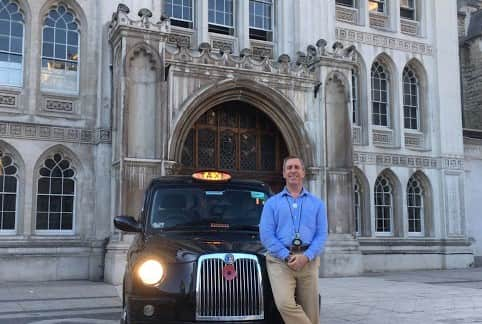When I drive my London Black Taxi across Westminster Bridge, the wonderful view of Old Father Thames against the back drop of the Palace of Westminster reminds me of what a great city we live and work in. I often reflect upon its foundation and development over the last two millennia.
Being an ex-soldier I have a particular interest in military history and am fascinated in how the development of London is intertwined with the story of this nation’s military prowess. Those surging tidal waters of the Thames were first conquered by Roman legionaries whose military engineering skills built a wooden pontoon-style bridge, which was the first of many London Bridges.
At the end of Westminster Bridge we have the magnificent statue of the warrior queen Boudica who, reaping vengeance on the Romans, razed London to the ground. The scorched layer of clay beneath our streets is a testimony to that brutal time.
That same Thames brought Anglo-Saxons who created the seventh-century settlement Lundenwic. Its name later became ‘old wich’, meaning old port, giving us today’s Aldwych with its Clement Danes Church.
Having accommodated the Saxons, London from the ninth century onwards attracted the unwelcome attention of the Vikings. The year 842 was recorded in chronicles as one of ‘great slaughter’. In 851 the raiders returned with a huge fleet of 350 ships and reduced London to a charred waste – not the first or the last time! A series of summer campaigns in the following decade smashed the power of the Saxon kingdoms of eastern England and in 871-872 the Danes felt confident enough to sit out the winter in London. In 886, under the inspired leadership of the warrior King Alfred of Wessex, known as Alfred the Great, the English retook London. Alfred restored its walls, making it a key part of his frontier defence system of fortified ‘burghs’.
Physical defences were not the only form of defence in that period. London often provided vast amounts of silver to the annual ‘Danegeld’ tribute, paid to buy off the attackers. In 1014 the English, with the assistance of Olaf of Norway, enjoyed a brief moment of glory and literally pulled London Bridge from beneath the feet of their tormentors.
Standing with its back to the west wall of the Palace of Westminster is a statue of the controversial Oliver Cromwell, which brings us to the English Civil War period. London was firmly behind Parliament throughout the Civil War. As London was the largest city, chief port, centre of finance and traditional seat of government, whoever controlled it had a winning hand. So the capture of London was a primary aim of royalist strategy. In the autumn of 1642 London expected an attack from the west. Barricades were thrown across the main routes in and, on a Sunday morning in November, 24,000 men mustered at Turnham Green to face the impending assault. The battle of Turnham Green was rather a damp squib with a feigned cavalry charge from the royalists, a minor artillery barrage. And then the royalists retired to Kingston. It was a strategic victory for the parliamentary forces. London expected a further attack and prepared frantically, conscripting all the available population, including women and children, to dig trenches. Many times in London’s history its civilian inhabitants have rallied to its defence. Expert engineers were brought over from Holland and work was continued even on a Sunday, which was a hard decision for the Puritan conscience. The people of London created ‘the lines of communication’, a circuit of more than 20 forts and batteries, linked by a nine-foot-high earth rampart and a nine-foot-deep ditch, which gave London the largest defensive fortifications in all Europe. The scale of the works can be judged from the fact that the ironically named Fort Royal, which stood where the Imperial War Museum now stands, held no fewer than 3,000 men. But the attack never came. The king was defeated in the field and after 1647 the defences were so thoroughly dismantled that almost no trace of them remains.
“The lamps are going out over Europe. We shall not see them lit again in our lifetime.” These prophetic words were uttered by Sir Edward Grey, Britain’s Foreign Secretary, in his magnificent room overlooking St James’s Park and Horse Guards Parade on Monday 3 August 1914. By the end of both the First and Second World Wars, tens of millions of people across Europe had perished, leaving shattered cities and dispersed populations. London had taken its fair share of the punishment. In the middle of Whitehall rises the Cenotaph, the monument to the glorious dead of the First World War designed by the architect Edwin Lutyens. In its dignified simplicity it now commemorates the dead from all wars and is the UK’s national war memorial. Just beyond that is the national monument to the women of World War II, unveiled in 2005.
Not far away in Northumberland Avenue is a green hut for Hackney Carriage Drivers. For many years, these shelters have been London landmarks, where cabbies can take a break and have a cup of Rosie and a sandwich. One of the many groups of Londoners who risked and often sacrificed their lives during the London Blitz in WW2 were the Hackney Carriage Drivers. At the outbreak of WW2 the government requisitioned around 2,500 taxis to be converted to auxiliary firefighting engines with ladders strapped to the roof and tow bars fitted for trailer pumps. They were also used as ambulances and army personnel carriers. Drivers were graded A3 (reserved occupation) and had to surrender their licenses. They became fireman and a considerable number of taxi drivers lost their lives as part of the auxiliary fire service.
Just about anywhere you look in London you can find something, whether it is a building or a statue or an open space, that can tell a story about military London. And there is so much more to tell………….
Blog by Ed




